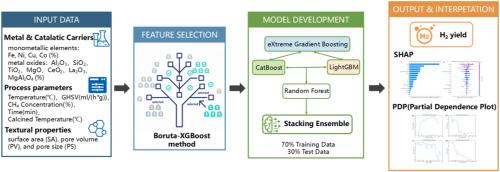通过混合Boruta-XGB和堆叠集成机器学习框架优化甲烷催化制氢
IF 8.3
2区 工程技术
Q1 CHEMISTRY, PHYSICAL
引用次数: 0
摘要
甲烷制氢是向清洁能源过渡的一项关键技术,但传统的催化剂开发依赖于昂贵且耗时的反复试验。本研究的目的是通过采用机器学习方法来提高甲烷催化制氢过程,以提高氢气产量并降低实验费用。机器学习模型是通过收集现有文献中的1772个数据点构建的。采用改进的Boruta算法进行特征筛选,结合Stacking集成学习方法构建预测模型。该方法通过系统分析输入参数和输出参数之间的关系,揭示了过程控制参数和催化剂设计对甲烷制氢过程的影响。然后使用SHAP和PDP解释工具揭示工艺参数和催化剂设计对制氢的影响,并确定关键的影响特征,如Al2O3含量、孔径(PS)、表面积(SA)和时间。研究结果表明,所建立的机器学习模型能够精确预测氢气产量,其中Stacking模型在测试集中表现出较好的预测性能,R2值为0.9544,RMSE值为5.8601,MAE值为3.0731。该研究为甲烷制氢催化剂的筛选和优化提供了有效的工具,工业应用是一个重点。该研究除了为工业应用提供实践指导外,还为阐明甲烷制氢机理提供理论支持,从而促进更高效催化剂的开发。本文章由计算机程序翻译,如有差异,请以英文原文为准。

Optimizing methane catalytic hydrogen production via a hybrid Boruta-XGB and stacking ensemble machine learning framework
Hydrogen production from methane is a crucial technology for the transition to clean energy, but conventional catalyst development relies on costly and time-consuming trial-and-error experiments. The objective of this study is to enhance the methane catalytic hydrogen production process by employing machine learning methodologies to augment hydrogen yield and mitigate experimental expenses. The machine learning model was constructed by the collection of 1772 data points from the extant literature. The improved Boruta algorithm was employed for the purpose of feature screening, and the prediction model was constructed by combining the Stacking integrated learning method. This method is capable of revealing the effects of process control parameters and catalyst design on the methane hydrogen production process by means of systematic analysis of the relationship between the input parameters and the output parameters. SHAP and PDP interpretation tools were then used to reveal the effects of process parameters and catalyst design on hydrogen production and to identify key influential features, such as Al2O3 content, pore size (PS), surface area (SA) and Time. The findings demonstrate that the machine learning models developed are capable of precise prediction of hydrogen production, with the Stacking model exhibiting superior prediction performance in the test set, as evidenced by an R2 value of 0.9544, an RMSE value of 5.8601, and an MAE value of 3.0731. This study provides an efficient tool for the screening and optimization of methane-hydrogen-producing catalysts, with industrial applications being a key focus. In addition to offering a practical guide for industrial applications, the study provides theoretical support that helps to elucidate the mechanism of methane hydrogen production, thereby promoting the development of more efficient catalysts.
求助全文
通过发布文献求助,成功后即可免费获取论文全文。
去求助
来源期刊

International Journal of Hydrogen Energy
工程技术-环境科学
CiteScore
13.50
自引率
25.00%
发文量
3502
审稿时长
60 days
期刊介绍:
The objective of the International Journal of Hydrogen Energy is to facilitate the exchange of new ideas, technological advancements, and research findings in the field of Hydrogen Energy among scientists and engineers worldwide. This journal showcases original research, both analytical and experimental, covering various aspects of Hydrogen Energy. These include production, storage, transmission, utilization, enabling technologies, environmental impact, economic considerations, and global perspectives on hydrogen and its carriers such as NH3, CH4, alcohols, etc.
The utilization aspect encompasses various methods such as thermochemical (combustion), photochemical, electrochemical (fuel cells), and nuclear conversion of hydrogen, hydrogen isotopes, and hydrogen carriers into thermal, mechanical, and electrical energies. The applications of these energies can be found in transportation (including aerospace), industrial, commercial, and residential sectors.
 求助内容:
求助内容: 应助结果提醒方式:
应助结果提醒方式:


